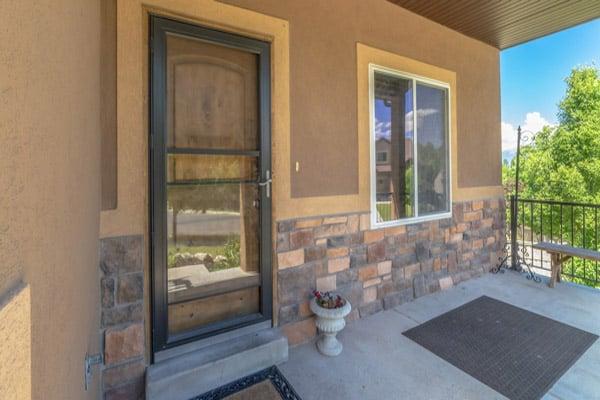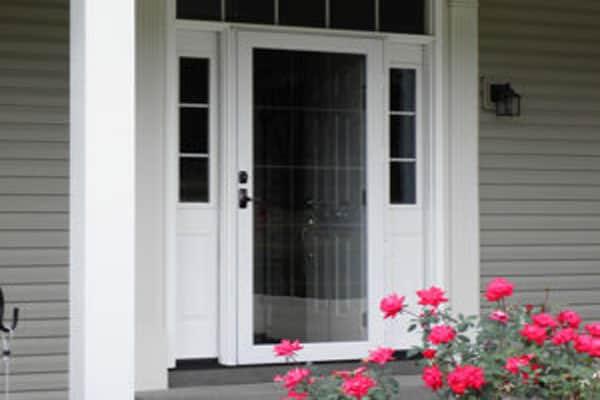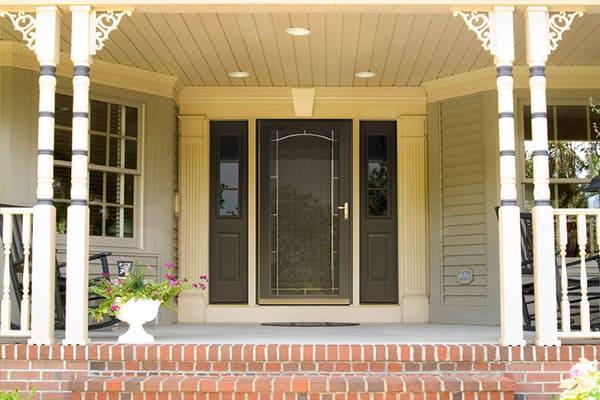What is a Storm Door?
By definition, a storm door is installed in front of an exterior access door for the purpose of protecting it from adverse weather. The storm door also allows for ventilation when the exterior door is left open.

Storm doors are manufactured from a variety of different materials like wood, aluminum, vinyl, or fiberglass. Storm doors are made in three basic styles: full-view, ventilating, or retractable screen.
Full-view storm door: this style has a full-length glass panel. Sometimes this style will include an interchangeable full screen.
Ventilating storm door: a ventilating storm door will allow for air to pass through either a full or half screen that always remains in position within the frame.
Retractable screen storm door: also referred to as a “roll screen”, this newer style is a combination of a full-view and ventilating storm door. The screen is connected at the top of the storm door. This lets you decide between a full-view storm door when the screen is rolled up or a ventilating door when it is down.
History of the Storm Door

The storm door was a near-essential part of the house. Back in the days before vinyl and fiberglass, homes were made of wood. Windows, doors, and everything in between was made of this most common material on the market. Exterior doors were no exception to this, but wooden exterior doors, not being made from the most weatherproof material, needed something else to protect it. Thus, the storm door arrived on the scene with a promise to protect and extend the life of exterior doors.
The screen door dates back to the 19th century Victorian era. During this period, manufacturers were able to mass produce materials like wire mesh and similarly, the technology existed to duplicate and produce wood frames. This high-volume production of wooden frames and wire mesh allowed for screen doors to reach all corners of the nation.
Before our cushy modern way of life, a storm door was also necessary for keeping out insects. While some insects like mosquitos still carry diseases, today’s medicine and health care prevents us from getting fatally ill over a bite. Back in the 1800s, keeping out insects meant protecting your entire family. Diseases spread easily then and medicines and treatments had a long way to go, so even a simple mesh door was a necessary layer of protection.
Origin of the Storm Door
It’s difficult to pinpoint the exact inventor of the storm door, however, in the midst of Civil War in 1861, an employee at a sieve making company called Gilbert and Bennett had an idea. The employee, with access to the company’s growing surplus of material due to the ongoing war, coated the wire cloth with paint in an effort to prevent rust when it was used as a window screen. The idea became incredibly popular and it wasn’t long before this wire screen made its way into a door frame, birthing the invention of a screen door.
Persisting Myths
There’s a circulating myth that states the screen door was invented in 1887 by a woman named Hannah Harger in Manhattan, Iowa. While it would be nice to credit the inventor of the screen door, there’s simply no record of a person by that name ever living in Manhattan, Iowa.
Read more : Why Is Vegemite Banned In The US?
The most accurate story we have of the screen door’s invention is that of the employee working at Gilbert and Bennet in 1861. It’s with this invention that made way for people to open their homes during a tumultuous time, letting in war-torn strangers, soldiers, and a comforting breeze.
Modern Storm Doors
Because exterior doors are largely made out of heavier duty materials like fiberglass or steel, the protective need for a storm door is no longer an imperative. Many consumers purchase storm doors out of habit, not realizing that the original purpose of the storm door was to serve as an extra layer of protection as the wood would become warped or crack over extended periods of exposure to foul weather.

However, storm doors still provide ventilation. Even if your steel or fiberglass exterior door no longer requires additional protection against warping and cracking, nearly all homes could use a nice breeze during a pleasant spring or summer day. Thanks to better manufacturing processes and modern technology, the cost of adding a storm door is nowhere near as pricey as it once was. Even if these additions are no longer a necessity, the cost is low enough to include a storm door for just a simple breeze.
Storm doors still serve a purpose to modern homeowners. Although these doors may not protect against bad weather as much as they once did, they still serve as an extra layer of security for an exterior door.
Join the 500,000 happy customers who have chosen Feldco for their home improvement needs. Treat yourself to a happier, healthier and brighter home. Speak to a product specialist about all of our different storm doors and get a free quote today!
Source: https://t-tees.com
Category: WHY
